Millions of shoppers worldwide visit Amazon during Prime Day and browse the deals or search for attractive discounts and bargains on specific products from their wish list. For the traffic alone it is worth setting up your Amazon Prime Day strategy!
Since the first Prime Day on Amazon’s 20th birthday in 2015, the event has reliably broken the previous year’s sales record every year. In 2023, Prime members have shopped and saved more than on any previous Prime Day and spent more than 12 billion U.S. dollars worldwide.
Here’s a quick look at the statistics. From 2016 on, estimated global sales of Amazon on Prime Day from 2016 to 2023 (in billions of U.S. dollars) show a steady surge:
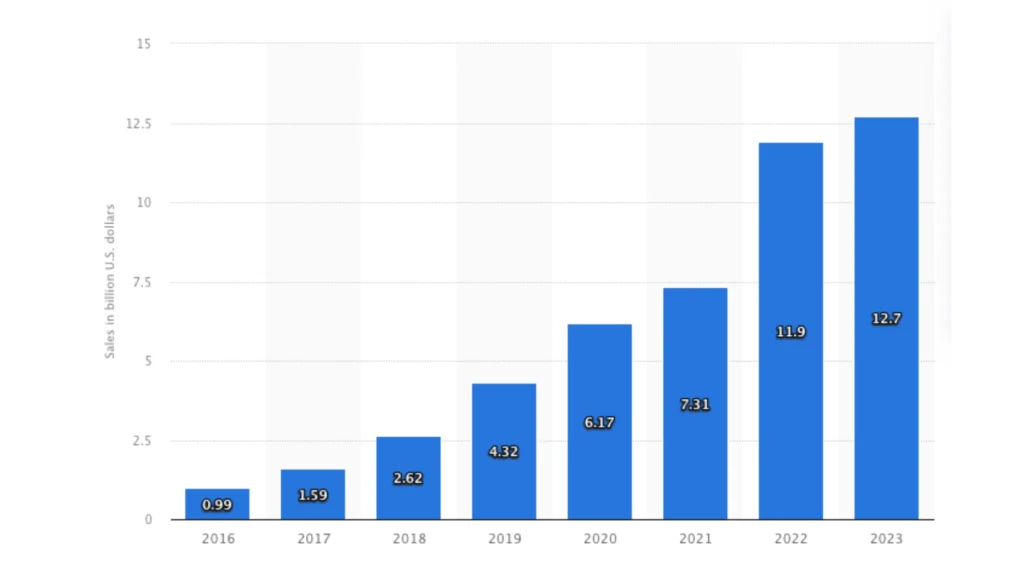
Your advantage is obvious:
More traffic = more potential sales + the chance to increase brand awareness.
The not-so-good news?
If you want your products and offers to be visible during Prime Day, you cannot avoid running Amazon Ads. The battle for advertising space on Amazon is particularly fierce for during this time and also more expensive.
But hey, don’t let that stop you from advertising on Amazon! Participating in Prime Day in general has a great sales potential. Users are more likely to buy during Prime Day and on the other hand Amazon Ads see more conversions.
Often shoppers wait for the sales events like this because they expect offers. And the rate of impulse purchases increases as well!
Afraid of the competition? You don’t need to be. Your Amazon PPC ads can perform well despite the competition if you do:
- Right preparation
- Detailed PPC campaign monitoring
- Quick adjustments during Prime Day
- Leveraging follow-up ad campaigns after the event.
How exactly can I do all this? I will explain exactly how, so keep reading.
Pro Tip
Are you already running Amazon Ads? Then first check if you covered the Amazon PPC strategy basics and you are building your ads on a solid foundation.
1. Before: How to prepare for Amazon Prime Day?
Let’s start! Here are the most important points you should take into the account when preparing not only your Amazon Prime Day strategy, but also advertising campaigns, listings and logistics:
- 2 weeks before Prime Day: start Amazon PPC advertising
- Look through Prime Day historical data
- Choose the right products
- Amazon Ads campaign types
- Defensive strategy for Prime Day: bid on your own brand keywords
- Increase daily advertising budget
- Increase stock, prepare Amazon FBM option
- Optimize Amazon product listings

When is Amazon Prime Day 2024?
Prime Day 2024 is set for 16-17 July.
2 Weeks Before Prime Day: Start Amazon PPC Advertising
If you haven’t run any Amazon Ads campaigns yet, you should at least 2 weeks before Prime Day. Why?
- According to Amazon surveys, 75% of shoppers are very likely to buy a product during Prime Day that they have already discovered in the lead-up to the event.
That’s why you should advertise your products to Amazon users who are willing to buy. I recommend you to use Sponsored Ads campaign type before and during Prime Day.
There’s another reason. Advertising campaigns need at least 2 weeks to collect enough data for PPC optimization:
- Which keywords, category and ASIN targeting work well?
- Which ones should be moved from an automated campaign to a manual one in order to bid on them specifically on Prime Day?
If there is enough data, you can answer those questions already before Prime Day. Based on the results you can optimize your Amazon PPC campaigns and efficiently use your advertising budget.
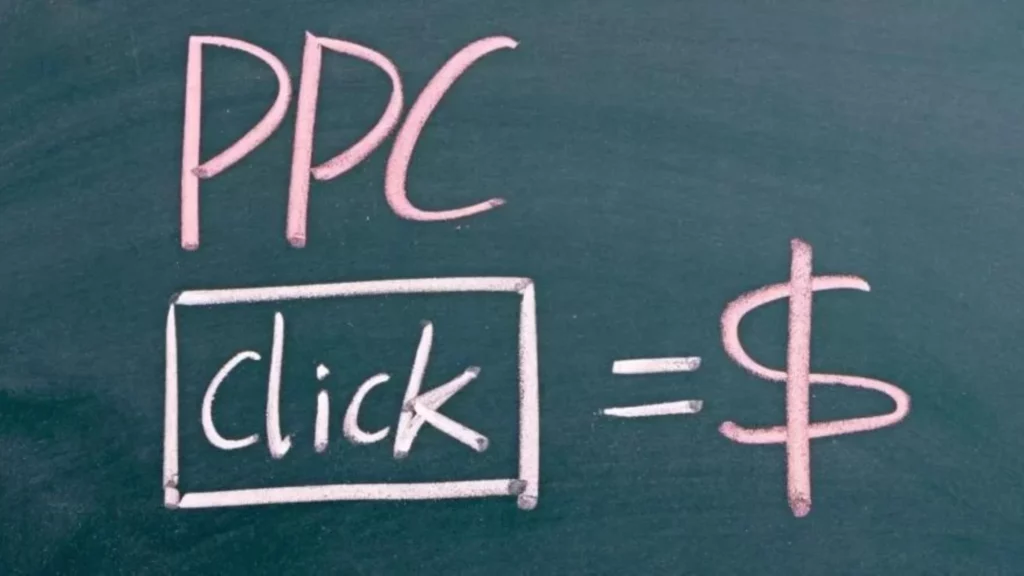
Look Through Prime Day Historical Data
If you have been selling on Amazon for a while, you should also take a look at the data from previous years and ask yourself:
- Which products did well?
- Which keywords performed particularly well?
- Which did not?
Your answers to these questions are a valuable starting point to set your Amazon Prime Day strategy.
Amazon Prime Day 2022: 3 key findings
After July 2022 we rolled up our sleeves and dug deep into the Adspert data. We came to 3 key conclusions about Prime Day 2022:
- Shoppers were well aware of the sale event & waited for it to shop.
- Lower-priced items won the game.
- Less competition – Fewer businesses advertised and the ones that did, did not need to increase their bids that much.
All findings are drawn based on an in-depth analysis. If you are interested in other details such as conversion rate around Prime Day, cost per conversion, conversion value and more, read the full report on all three Amazon Prime Day 2022 insights.
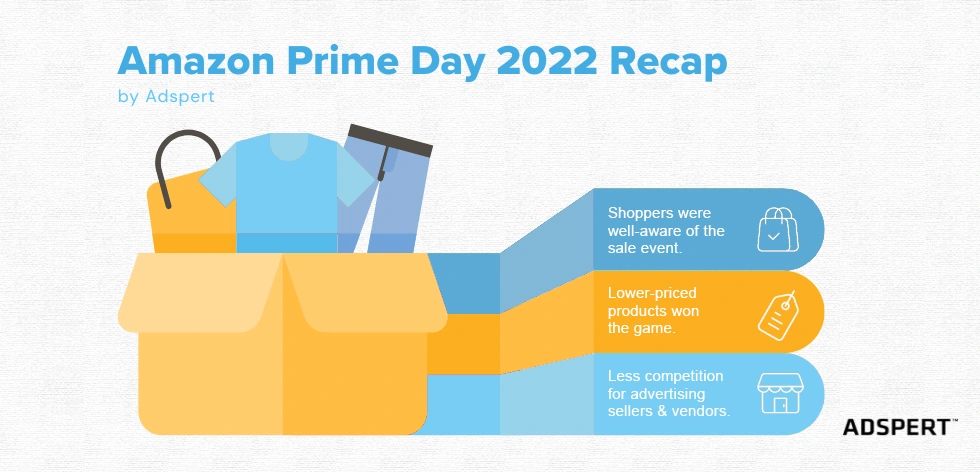
Choose the right products
Like anyone, you might be tempted to try and get rid of your slow selling products from your website during Prime Day. Avoiding long-term storage fees is very appealing.
Where is the catch? This strategy can work, but it can also backfire. If sales of the product were already extremely weak, Prime Day probably won’t change that.
It makes more sense to invest your advertising budget in:
- Products with deals (e.g. Lightning Deal, coupons …)
- Best sellers
- Well-rated products (more than 3.5 stars)
In addition to increased sales, advertising your best performance can also improve their sales rank at the same time.
And with that increase, you might see higher sales figures for weeks after Prime Day (so-called brand halo effect).

Amazon Ads Campaign types
After you have an idea about which products you will include in your Amazon Prime Day strategy, continue with selecting ad campaign types AND targeting.
Sponsored Products campaigns
When you decide to run ads under Sponsored Products campaign type, think about strategic targeting. You can target by:
- Product type
- Brand
- Product price
- Single, multiple or large packs
- Keyword type
- and similar
Strategic targeting makes your ads more specific in the promotion of keywords. Plus you can better monitor the performance of individual campaigns and products.
Another good practice you should follow is using consistent pattern for campaign naming (e.g. PrimeDay2022_ProductType_KeywordType). In the long run this also helps you to monitor your campaigns.
Sponsored Brands campaigns
In addition to Sponsored Product ads, I also strongly advise you to run Sponsored Brands campaigns before and during Prime Day. This way, you increase your chances to fill up more of the available advertising placement during peak sales.
You will maximize the visibility of your products and brand and increase the chances to grow your sales.
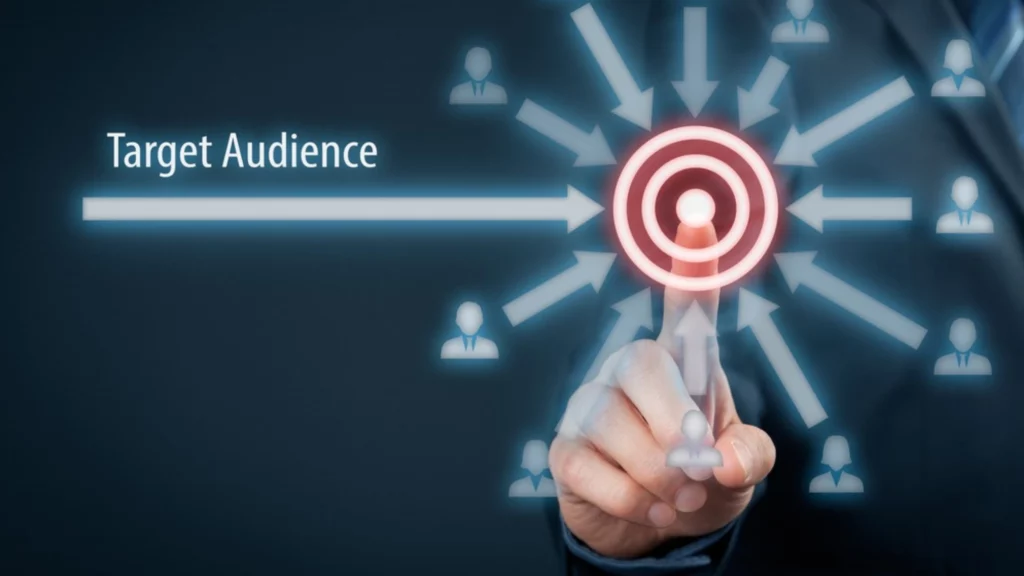
Defensive Strategy for Prime Day: Bid on Your Own Brand Keywords
It is not uncommon for other Amazon sellers or vendors to bid on your brand terms and products. What’s the idea behind it? They want to tap into your brand traffic by promoting their own products!
If you don’t usually bid on your own brand keywords, at least do it during Prime Day. You will draw the defense line and protect your brand.
Increase daily advertising budget
- Go to your Amazon Seller Central
- Increase your daily budget 2 weeks before Prime Day.
- Your ads should become more visible and generate more data for optimization.
At the latest on Prime Day itself, your daily budget should at least twice as high as usual. If you can, it’s even better if you triple the amount to up the chances for success.
Increase stock and prepare Amazon FBM
One of the worst things that can happen to you during any sales event is to run out of stock. Review and replenish your inventory way ahead of time!
A lot of other retailers are doing the same which can cause bottlenecks in supply and delivery. It’s best if you double or even triple the lead time.

And even in cases when you have enough stock, it can happen that your deliveries can’t get out on time. An excellent back up is to set up Amazon FBM – Fulfilled by Merchant. If things go south, you will already have a plan B and won’t need to scramble finding out a solution at a critical moment.
Using Amazon FBM doesn’t mean you need to ship everything yourself. You can also use an external warehouse or vendor that will handle it in your stead.
Optimize Amazon product listings
You should optimize your product listings on a regular basis to boost your organic sales. When you start advertising on Amazon, this is even more the case.
More than that, add listings to your Amazon Prime Day strategy checklist! Why? Because keeping them updated is not enough.
Take a look at each listing and improve:
- Product title
- Product description
- Images
- Other product listings elements
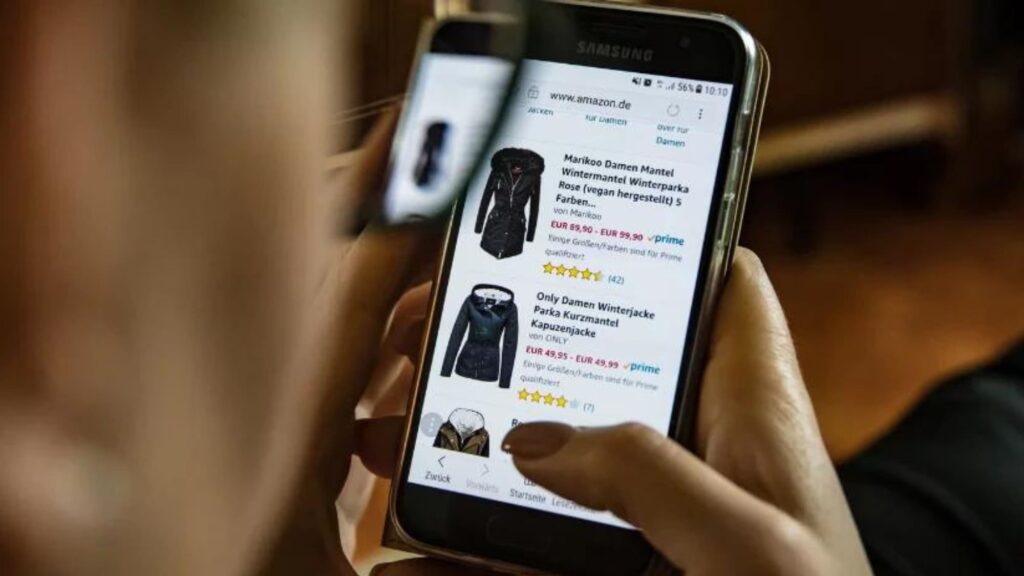
Optimize Your Product Listings for Mobile View
Mobile sales are getting stronger and stronger so you should optimize your product listings for mobile view as well.
When was the last time you checked how your listing looks on your mobile? Roll up your sleeves and make sure your mobile view on Amazon includes:
- main image
- other images
- images are supplemented by a short and concise text that contains main product benefits
- use comparison tables (e.g. your product vs. competition)
- add a video of the product
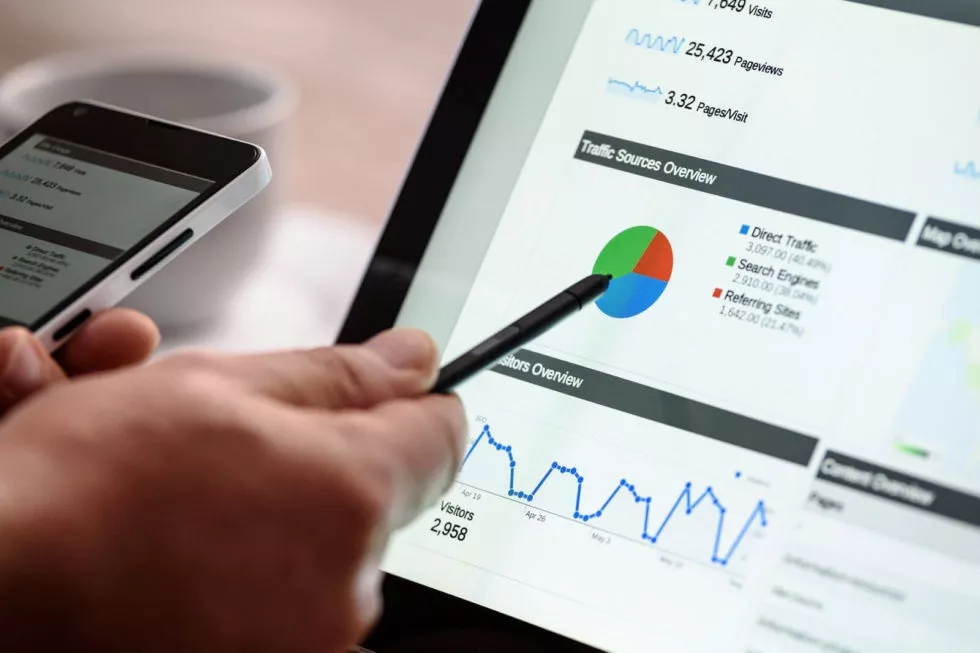
To sum up, start preparing your Amazon Ads strategy early. Review your own historical data and select the right products for Prime deals.
Plus check reports from previous Prime Day sales to get a feeling of what you can expect from other Amazon advertisers. You can also check Amazon for additional Prime Day advertising tips.
Start running your Amazon PPC campaigns at least 2 weeks before Prime Day. If you are not running Sponsored Brands ads, the time is now!
Fill up your stock and consider using Amazon FBM to try to speed up your deliveries. Sounds like a lot of work? It will pay off, wait and see when Prime Day comes!
2. During: Amazon Prime Day Marketing Strategy
During Amazon Prime Day monitoring is your most important action. When I say monitoring, I don’t mean only PPC monitoring, I also mean monitoring of your stock and customer reviews.
Monitor Your Amazon PPC Campaigns
During Prime Day, regularly check the performance of your Amazon PPC campaigns and adjust them if necessary.
Monitoring your advertising campaigns benefits:
- Prevent running out of budget – increase daily budgets in time if they are used up too early in the day
- Push your best-performers – make ad-hoc adjustments to bids for keywords or product targeting attributes (ASINs, categories, etc.) that are performing particularly well. By increasing the bids on your best-performers generates even more impressions and increases the chances to maximize sales
- Prevent losing money – if your ads are not getting enough impressions and clicks, this could mean your competition is beating you. Increase the bids to stay ahead of the competition on Prime Day and don’t waste your advertising budget.
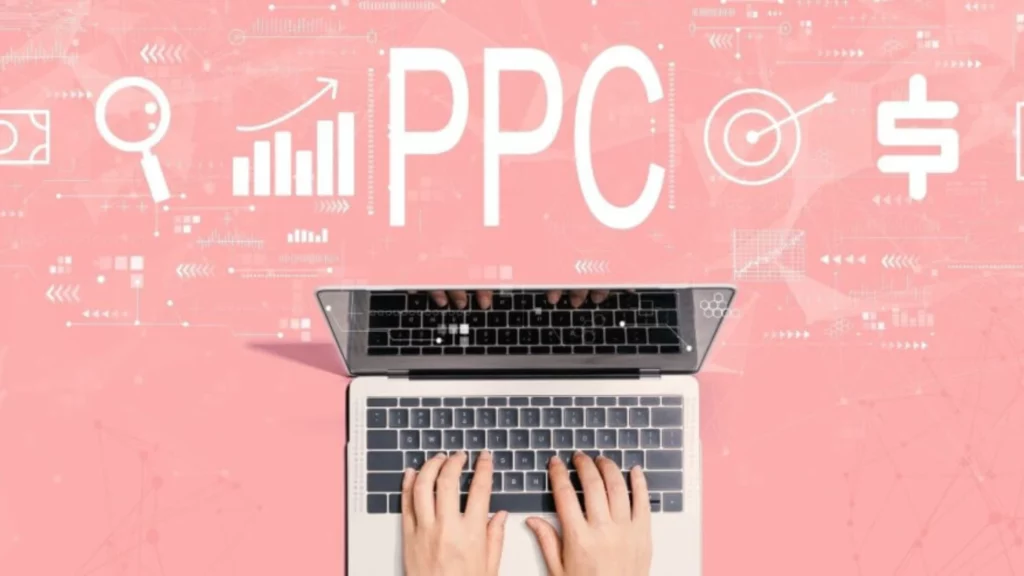
Keep an eye on stock levels
Increasing your stock before Prime Day is just as important as monitoring stock levels during the sales. If the stock levels of any product are getting close to 0, act fast!
Running out-of-stock has a negative impact on both sales and advertising campaigns. So make sure it doesn’t come to that.
If you detect you could have stock issues, then consider falling back to Amazon FBA and fulfill your orders with in-house shipping. If you have done homework, you should have the system already in place.
Respond immediately to customer inquiries and reviews
During Prime Day, shoppers often compare several products with each other and ask questions about them. Sellers that react quickly and provide answers fast usually gain a competitive advantage.
Respond to every customer inquiry and review as soon as possible. This just might be what separates your from the competition and seals the deal!
Extra tip: if you notice that certain questions keep repeating, then update your product detail page. Like this you will already answer the most common questions about the product and save your customer service time.

In short, you will be busy during Prime Day on Amazon. You should be monitoring your Amazon PPC campaigns with one hand and responding to customers with the other.
There may be a point when you will be completely swamped and you might let some replies slip through or miss a day to optimize your ads.
That’s ok as long as you don’t make it a habit. But whatever you do, don’t forget about your stock! If you run out of inventory, you will lose sales and waste your advertising budget.
3. After Prime Day Strategy
Special promotions are over – but your sales don’t need to be! You can still benefit well after the sales event. Consider including these tips to your Amazon Prime Day strategy:
Keep running your top Amazon PPC campaigns
Even after Prime Day, customers continue browsing Amazon for products they did not buy during the event. After all, the sales event is limited to only 48 hours and shoppers might have simply missed it, but are still hoping for post-Prime-Day deals.
So don’t switch off your Amazon advertising right after the official sales are finished.
If some of your ad campaigns are performing really well, keep running them. Look at your profit. In a lot of cases it makes sense to invest part of the profit into online advertising to generate new sales.

Use Sponsored Display ads for retargeting
Have shoppers visited your product details page, but did not end up buying your product? Then they are perfect candidates for retargeting!
Maybe they didn’t complete the purchase on time or stopped after adding the item to the cart. Maybe shoppers haven’t had a chance to do their research to make a purchase decision. Or they simply need more engagement for the final decision.
Showing them ads of your product on AND off Amazon might just be the push they need to buy your product.
How to Set Up Sponsored Display ads for retargeting?
- Go to your Amazon advertising account
- Set up Sponsored Display ads
- Select targeting option “Views Remarketing”
Reserve more time for customer support
While Prime Day is a good opportunity to increase sales, you also have to expect increased workload related to follow up after the event. After all, when you sell more products, you also get more:
- Customer inquiries
- Returns
- Refunds
When planning your workload around Prime Day, count on carving out more time for your customer support after the sales are finished.

Gather insights for next Amazon sales events
Whether Prime Day went as well as expected or not, you get valuable insights. Use the questions below and store the answers.
This will help you create a short report about what went well and what not:
- Which keywords, ASINs and product categories did well?
- Which ones did rather poorly?
- Which products sold particularly well?
- Which ones did particularly poorly? Which daily budget is optimal?
- With which bids did you achieve the best visibility?

All of this is useful information for the next Amazon event. You can then use the learnings during next sales events:
- Amazon Black Friday
- Cyber Monday
- potential Prime Day in October
- next Prime Day
Prime Day is over, but this doesn’t mean your sales need to end too! A big part of your Amazon Prime Day strategy should be to try to extend the sales hype.
How? See which PPC campaigns are your top performers and keep running them. Leverage them as your touchpoint with potential buyers.
Use Sponsored Display ads for retargeting. Lure back all users that visited your product details page but did not complete the purchase. There’s a big likelihood they will open their wallets a second time around!
Last but not least, check your analytics report. Dive into the analytics data, analyze your Amazon PPC performance and use the findings for the next Amazon sales event.
4. Special: Prime Day Strategies for Adspert users
Automatic Amazon PPC optimization for sales events
You can boost your sales on Prime Day with good planning, early preparation and a well thought-out advertising strategy and optimization.
On top of that I also prepared additional recommendations for Adspert users. If you use Adspert, you can leverage the Event Mode.
Adspert Event Mode
At its core, Adspert’s optimization is focused on scalability and robustness. Bids are adjusted gradually. Why? Because a single day with a higher or lower conversion rate does not immediately set a future trend. Under normal circumstances, our smart AI does not abruptly increase or decrease bid.
But when it comes to sales events like Amazon Prime Day, sudden bidding changes are often necessary. For this reason, we developed the Event Mode.
Event Mode makes it easier to react quickly to changing conversion rates and CPCs during sales events such as Prime Day, Black Friday and similar.
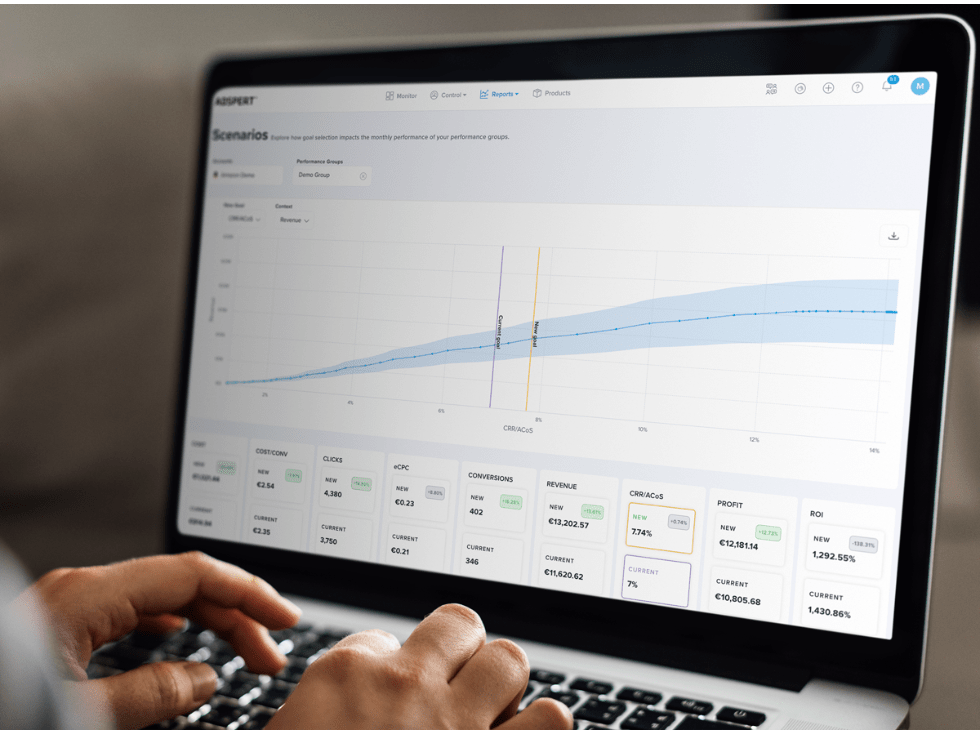
During sales events Adspert automatically switches to this mode. The Event Mode temporarily overrides the moderate bid adjustment. This means the AI adjust bids considerably in a very short time – both upwards spike (strong-selling events) and downwards (weak-selling events).
Furthermore, around the sales event (max 14 days) Adspert algorithm assumes a significant change in the core metrics (e.g. significantly increased/decreased conversion rate or significantly increased/decreased CPCs) and takes this into account when setting the bids.
After the event is over, the system automatically switches back to normal operation mode and reverts the bids to the level from before the event.
Final Thoughts
Coming up with Amazon Prime Day strategy can be a tough nut to crack. There’s so much to think about: your products, Prime Day deals and offers and on top of that how to handle your Amazon PPC strategy.
In this article I listed useful tips on how to prepare for Amazon Prime Day. I broke it down into what to do before, during and after the sales event.
I hope that I was able to assist you in transforming the challenging project of preparing for Prime Day into a more achievable task.
What’s the bottom line? If you follow all tips and steps listed above, your Amazon PPC ads will most likely perform better during Prime Day and your sales should increase.
FAQ – Adspert Event Mode
Do I need to activate or edit Adspert’s Event Mode myself?
No. The Event Mode is a service managed by Adspert. This means that there is no user interface for it and it runs in the background.
However, Adspert Enterprise customers have the option to modify the Event Mode. You can choose to optimize only selected campaigns in Event Mode instead of the entire account. Or you can define the time periods for which the Event Mode should be activated/deactivated. If you have the Enterprise plan, you can also define your own events in addition to global events such as Prime Day. To do this, contact your Adspert representative to activate the mode for the desired campaigns and time periods.
Should I adjust my Performance Group goals in Adspert?
Yes, I recommend you to:
- Adjust your Performance Group optimization goals in light of the global sales events like Prime Day, Cyber Monday or Black Friday. For example, set a higher ACoS target to get your products more visible.
- Increase the goal for Performance Groups with a cost/month (or cost/day) goal a few days before the positive (high-selling) event and lowering it for a negative (low-selling) event.
- (Enterprise plan only) Specify which campaigns or Performance Groups should run in the Event Mode. Contact your Adspert representative and we will help you out.
What else should be considered during a sales event?
It is very important to increase your advertising budgets during a strong selling event. Adspert is very likely to increase CPCs during a sales event like Prime Day.
If there is not enough budget, your ads might not run throughout the entire day because it was used up too quickly. Don’t lose valuable traffic!




